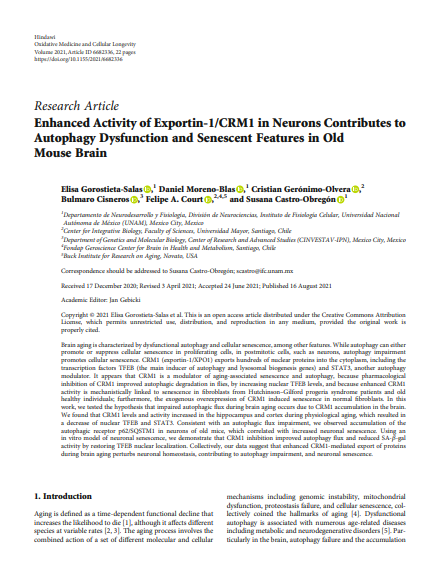Enhanced Activity of Exportin-1/CRM1 in Neurons Contributes to Autophagy Dysfunction and Senescent Features in Old Mouse Brain

Fecha
2021-08-16Autor
Gorostieta-Salas, Elisa
Moreno-Blas, Daniel
Gerónimo-Olvera, Cristian [Univ Mayor, Fac Sci, Ctr Integrat Biol, Chile]
Cisneros, Bulmaro
Court, Felipe A. [Univ Mayor, Fac Sci, Ctr Integrat Biol, Chile]
Castro-Obregón, Susana
Ubicación geográfica
Notas
HERRAMIENTAS
Acceda a títulos restringidos
¿Cómo descargar?Resumen
Brain aging is characterized by dysfunctional autophagy and cellular senescence, among other features. While autophagy can either promote or suppress cellular senescence in proliferating cells, in postmitotic cells, such as neurons, autophagy impairment promotes cellular senescence. CRM1 (exportin-1/XPO1) exports hundreds of nuclear proteins into the cytoplasm, including the transcription factors TFEB (the main inducer of autophagy and lysosomal biogenesis genes) and STAT3, another autophagy modulator. It appears that CRM1 is a modulator of aging-associated senescence and autophagy, because pharmacological inhibition of CRM1 improved autophagic degradation in flies, by increasing nuclear TFEB levels, and because enhanced CRM1 activity is mechanistically linked to senescence in fibroblasts from Hutchinson-Gilford progeria syndrome patients and old healthy individuals; furthermore, the exogenous overexpression of CRM1 induced senescence in normal fibroblasts. In this work, we tested the hypothesis that impaired autophagic flux during brain aging occurs due to CRM1 accumulation in the brain. We found that CRM1 levels and activity increased in the hippocampus and cortex during physiological aging, which resulted in a decrease of nuclear TFEB and STAT3. Consistent with an autophagic flux impairment, we observed accumulation of the autophagic receptor p62/SQSTM1 in neurons of old mice, which correlated with increased neuronal senescence. Using an in vitro model of neuronal senescence, we demonstrate that CRM1 inhibition improved autophagy flux and reduced SA-beta-gal activity by restoring TFEB nuclear localization. Collectively, our data suggest that enhanced CRM1-mediated export of proteins during brain aging perturbs neuronal homeostasis, contributing to autophagy impairment, and neuronal senescence.
URI
https://repositorio.umayor.cl/xmlui/handle/sibum/9165https://www.ncbi.nlm.nih.gov/pmc/articles/PMC8382534/pdf/OMCL2021-6682336.pdf
https://doi.org/10.1155%2F2021%2F6682336
https://downloads.hindawi.com/journals/omcl/2021/6682336.pdf?_gl=1*17urkrp*_ga*MTE5MzM2ODk3Ni4xNzAzNzAxMTg2*_ga_NF5QFMJT5V*MTcwMzcwMTE4Ni4xLjAuMTcwMzcwMTE4Ni42MC4wLjA.&_ga=2.98968541.2140624633.1703701186-1193368976.1703701186
Coleccion/es a la/s que pertenece:
Si usted es autor(a) de este documento y NO desea que su publicación tenga acceso público en este repositorio, por favor complete el formulario aquí.